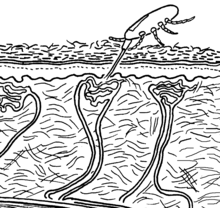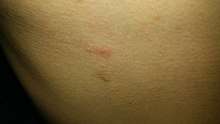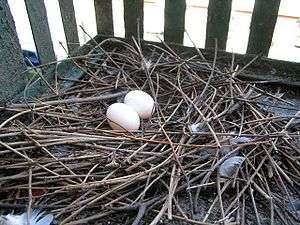Gamasoidosis

Gamasoidosis (also known as acariasis, avian-mite dermatitis or bird-mite dermatitis)[1] is a frequently unrecognized ectoparasitosis[2] occurring after contact with avian mites which infest canaries,[3] sparrows, starlings, pigeons[4] and poultry[5] and caused by two genera of mites, Ornithonyssus and Dermanyssus.[6] Avian mite species implicated include the red poultry mite (Dermanyssus gallinae),[7] tropical fowl mite (Ornithonyssus bursa)[8] and northern fowl mite (Ornithonyssus sylviarum)[7]. Mite dermatitis is also associated with rodents infested with the tropical rat mite (Ornithonyssus bacoti),[9][10] spiny rat mite (Laelaps echidnina)[11] and house-mouse mite (Liponyssoides sanguineus), where the condition is known as rodent mite dermatitis.[12] Urban gamasoidosis is associated with window-sills, ventilation and air-conditioning intakes, roofs and eaves, which serve as shelters for nesting birds. Humans bitten by these mites experience a non-specific dermatitis with intense itching.[13][14]
Symptoms
The most common symptoms are "itching and punctiform, erythematous papules"[13] with a "central punctum",[15] the itching and irritation are reactions to the saliva the mites secrete when feeding.[8]
Bites are normally located in groups around the neck and body areas covered by clothes (waist, trunk, upper extremities and abdomen),[9][16] but can also be found on the legs,[13] finger webs, axillae, the groin, and buttocks.[17]
D. gallinae is capable of infesting the ear canal, with symptoms including itching, internal inflammation and discharge.[18] It can also infest the scalp, with severe itching—particularly at night as the primary symptom.[19]
Additional symptoms include pinpricks, secondary infections, scarring, hyperpigmentation as well as psychological trauma resulting in anxiety and depression.[20]
Diagnosis
Diagnosis can be challenging as the small size of avian mites make them "barely visible to the unaided eye".[21] Identification of the species is best carried out by a medical entomologist using a microscope,[7] positive identification of species is critical for recommendation of suitable treatment. Samples can be obtained using corrugated cardboard traps, left in infested areas.[22]
Diagnoses of gamasoidosis have a long history, with "cases [...] reported since the 17th century, documented in the leading medical literature since at least the 1920s.".[23] Avian and rodent mites have been documented infesting residential buildings, work spaces, schools and hospitals.[9][23] Despite this, there is considered to be widespread ignorance and misinformation "regarding human infestation with D. gallinae across healthcare, science and pest control fields", which in turn has led to increasing numbers of infestations and a dangerous propagation of the disease.[20] Due to it being an uncommon diagnosis, gamasoidosis may be misdiagnosed as scabies or pediculosis[24] or bites mistakenly identified as coming from bed bugs.[25] Many cases of gamasoidosis go unreported, suggesting that the actual incidence is higher than generally believed.[5] As a result, in cases of unexplained bites in residential areas, the involvement of D. gallinae should always be considered,[13] especially during late spring and early summer when wild birds make their nests.[17]

The life cycle of the mite is another important method of diagnosis.[20] Hematophagic mites generally feed at night[26] but may also feed during the day if the room is sufficiently dark.[27] O. bursa is an exception as it generally remains on its hosts and will feed during the day.[28] D. gallinae may be commonly found in the bedroom or where the patient sleeps, as they prefer to stay close to their host for optimal feeding.[29] They are attracted to warm hiding places that simulate the body temperature of birds (e.g. pigeons 42 °C), "such as the electrical devices running in stand-by mode (e.g. laptop computers, television, radio clocks etc.)" which generate heat. As a result, "it is strongly recommended to check these electrical appliances for the mite detection".[13] D. gallinae generally visit their host for up to 1–2 hours, leave after completing their blood meal[13] and typically feed every 2–4 days.[23] They are able to move extremely quickly[15] and can take less than 1 second to bite, enough time to inject their saliva and to induce rash and itching.[13] They locate potential hosts through temperature changes,[13] vibration and CO².[30][31]
It has been hypothesized the D. Gallinae is capable of 'learning'[32] "to associate non-host skin with a blood-meal if the host selection process permitted feeding."[23] Combined with a generalist approach to finding hosts and the capability of digesting non-avian blood could potentially explain their documented host expansion to mammals and humans.[23]
There is documented "co-occurrence of gamasoidosis and various immunosuppressive disorders"[23] and physicians should bear in mind that immunocompromised patients, patients that take corticosteroids, and patients with dementia may have a more severe infestation than healthy patients,[20] Despite this, while immunosuppression can "increase susceptibility, it is not necessarily a pre-requisite for infestation".[23]
Dermatoscopy can help to exclude the diagnosis of delusional parasitosis.[2]
Pets such as canaries,[13] cats,[33] dogs[34] and gerbils[15] can be infested also, diagnosis can be made by examining their feathers or fur for mites and is best carried out by a veterinary professional.
Treatment
Treatment of gamasoidosis can be difficult, avian mites have developed resistance to multiple pesticides and the different species concerned display varied ecologies that necessitate divergent treatment approaches.[20]
For a patient to achieve full recovery, the mites must be eradicated from the person's environment through the removal of nests and appropriate disinfestation of infested areas by a pest control professional.[14] Total eradication can be difficult to achieve as D. gallinae can survive for longer than 9 months without a blood meal[35][36] and is capable of both digesting[37] and completing its life cycle on human blood alone.[19] Additionally, populations can expand rapidly, with a single female capable of laying up to "30 eggs in their lifetime".[38]

Patients are advised to:
- Clean household items with effective acaricides.
- Remove infected animal shelters, cages and nests.
- Dust infested areas with amorphous silica gels[39] such as Cimexa.
- Heat treat their residence - raising the temperature of their living space above 55 °C.
- Washing their clothes with detergent at high temperatures.[40]
- Reduce the relative humidity of their home below 55%.
- Shower frequently to remove mites from the skin.
- Perform regular intensive vacuum cleaning.[13]
- Take preventative measures to stop birds returning to their nesting sites.[16]
Fluralaner, an effective acaricide, available commercially as Bravecto[41] may be administered to cats and dogs after consulting a vet.
Antihistamines and topical corticosteroids can be used for temporary relief of symptoms.[42]
Certain essential oils are known to have an acaricide effect on avian mites.[43] Cardboard traps impregnated with neem extracts or other acaricides[44] can be used to reduce avian mite populations.[45]
In the case of scalp infestation, treatments with 1% permethrin shampoo can be used to remove the mites.[26] For ear canal infestation, aural toilet is recommended with a course of 1% permethrin to be used as ear drops and for infected wax to removed by a professional.[18]
Ineffective and often prolonged attempts to eradicate infestations commonly result in economic issues, due to a significant financial outlay when patients relocate and/or attempt to control these infestations.[20]
Epidemiology
D. gallinae poses a significant threat to public health as the mite may be vector/reservoir of zoonotic pathogens,[23] such as Chlamydia psittaci, Erysipelothrix rhusiopathiae, Salmonella spp., Lyme disease,[23] Mycobacterium spp., Coxiella burnetii, Bartonella spp.,[25] Borrelia burgdorferi,[46] Venezuelan equine encephalitis virus, Eastern equine encephalitis virus, and Fowlpox virus.[47]
See also
References
- ↑ Kowalska, M.; Kupis, B. (1976). "Gamasoidosis (gamasidiosis)-not infrequent skin reactions, frequently unrecognized". Polish Medical Sciences and History Bulletin. 15-16 (4): 391–394. ISSN 0301-0236. PMID 826895.
- 1 2 Wambier, Carlos Gustavo; Wambier, Sarah Perillo de Farias (2012). "Gamasoidosis illustrated - from the nest to dermoscopy". Anais brasileiros de dermatologia. 87 (6): 926–927. doi:10.1590/S0365-05962012000600021. ISSN 0365-0596. PMC 3699918. PMID 23197219.
- ↑ SULZBERGER, MARION B. (1936-01-01). "AVIAN ITCH MITES AS A CAUSE OF HUMAN DERMATOSES". Archives of Dermatology and Syphilology. 33 (1): 60. doi:10.1001/archderm.1936.01470070063006. ISSN 0096-6029.
- ↑ Sparagano, O. a. E.; George, D. R.; Harrington, D. W. J.; Giangaspero, A. (2014). "Significance and control of the poultry red mite, Dermanyssus gallinae". Annual Review of Entomology. 59: 447–466. doi:10.1146/annurev-ento-011613-162101. ISSN 1545-4487. PMID 24397522.
- 1 2 Sigognault Flochlay, Annie; Thomas, Emmanuel; Sparagano, Olivier (2017-08-01). "Poultry red mite (Dermanyssus gallinae) infestation: a broad impact parasitological disease that still remains a significant challenge for the egg-laying industry in Europe". Parasites & Vectors. 10: 357. doi:10.1186/s13071-017-2292-4. ISSN 1756-3305. PMC 5537931. PMID 28760144.
- ↑ James, William D.; Berger, Timothy G.; et al. (2006). Andrews' Diseases of the Skin: clinical Dermatology. Saunders Elsevier. ISBN 0-7216-2921-0.
- 1 2 3 Orton; Warren; Wilkinson (2001-12-24). "Avian mite dermatitis". Clinical and Experimental Dermatology. 25 (2): 129–131. doi:10.1046/j.1365-2230.2000.00594.x. ISSN 0307-6938.
- 1 2 Mentz, Márcia Bohrer; Silva, Guilherme Liberato da; Silva, Carlos Eugênio; Mentz, Márcia Bohrer; Silva, Guilherme Liberato da; Silva, Carlos Eugênio (2015). "Dermatitis caused by the tropical fowl mite Ornithonyssus bursa (Berlese) (Acari: Macronyssidae): a case report in humans". Revista da Sociedade Brasileira de Medicina Tropical. 48 (6): 786–788. doi:10.1590/0037-8682-0170-2015. ISSN 0037-8682.
- 1 2 3 Cafiero, M.A.; Raele, D.A.; Mancini, G.; Galante, D. (2015-04-24). "Dermatitis by Tropical Rat Mite,Ornithonyssus bacoti(Mesostigmata, Macronyssidae) in Italian city-dwellers: a diagnostic challenge". Journal of the European Academy of Dermatology and Venereology. 30 (7): 1231–1233. doi:10.1111/jdv.13162. ISSN 0926-9959.
- ↑ Hetherington, George W. (1971-03-01). "Rat Mite Dermatitis". JAMA: The Journal of the American Medical Association. 215 (9): 1499. doi:10.1001/jama.1971.03180220079019. ISSN 0098-7484.
- ↑ Watson, J. (2008-01-01). "New Building, Old Parasite: Mesostigmatid Mites--An Ever-Present Threat to Barrier Rodent Facilities". ILAR Journal. 49 (3): 303–309. doi:10.1093/ilar.49.3.303. ISSN 1084-2020.
- ↑ Alexander, John O’Donel (1984). Arthropods and Human Skin. Springer, London. pp. 303–315. doi:10.1007/978-1-4471-1356-0_17. ISBN 9781447113584.
- 1 2 3 4 5 6 7 8 9 10 Cafiero, M. A., Galante, D., Raele, D. A., Nardella, M. C., & Piccirilli, E. (2017). Outbreaks of Dermanyssus gallinae (Acari, Mesostigmata) Related Dermatitis in Humans in Public and Private Residences. Italy (2001-2017): An Expanding Skin Affliction. J Clin Case Rep, 7(1035), 2.
- 1 2 Cafiero, M. A., Camarda, A., Galante, D., Mancini, G., Circella, E., Cavaliere, N., ... & Lomuto, M. Outbreaks of Red Mite (Dermanyssus Gallinae) Dermatitis in City-dwellers: An Emerging Urban Epizoonosis. HYPOTHESES IN CLINICAL MEDICINE, 413.
- 1 2 3 Lucky, Anne W.; Sayers, C. Paul; Argus, J. David; Lucky, Andrea (2001-02-01). "Avian Mite Bites Acquired From a New Source—Pet Gerbils: Report of 2 Cases and Review of the Literature". Archives of Dermatology. 137 (2). ISSN 0003-987X.
- 1 2 de Oliveira Alves, Andreia; Bernardes Filho, Fred (2018). "Gamasoidosis (bird mite dermatitis): A case series in a family". Pediatrics & Neonatology. 59 (1): 102–103. doi:10.1016/j.pedneo.2017.08.001. ISSN 1875-9572.
- 1 2 Kong, Tak K.; To, Wing K. (2006-04-20). "Bird-Mite Infestation". New England Journal of Medicine. 354 (16): 1728–1728. doi:10.1056/nejmicm050608. ISSN 0028-4793.
- 1 2 Rossiter, A. (1997). "Occupational otitis externa in chicken catchers". The Journal of Laryngology and Otology. 111 (4): 366–367. ISSN 0022-2151. PMID 9176622.
- 1 2 Pampiglione, S.; Pampiglione, G.; Pagani, M.; Rivasi, F. (2001). "[Persistent scalp infestation by Dermanyssus gallinae in an Emilian country-woman]". Parassitologia. 43 (3): 113–115. ISSN 0048-2951. PMID 11921537.
- 1 2 3 4 5 6 Sparagano, Olivier,; Finn, Robert,; Mul, Monique,; Annunziata, Giangaspero,; CAFIERO,, MARIA ASSUNTA; Willingham, Natalie,; Lyons, Kirstie,; GEORGE,, AIMEE LOVERS AND DAVID (2017). "The emergence of Dermanyssus gallinae as an arthropod pest in urban context and the "one Health" approach. Proceedings of the 9th International Conference on urban pests".
- ↑ ,; , (2016-01-01). "Pruritic Dermatitis Caused by Bird Mite Infestation". Cutis. 97 (1).
- ↑ Nordenfors, Helena; Chirico, Jan (2001-12-01). "Evaluation of a Sampling Trap for Dermanyssus gallinae (Acari: Dermanyssidae)". Journal of Economic Entomology. 94 (6): 1617–1621. doi:10.1603/0022-0493-94.6.1617. ISSN 0022-0493.
- 1 2 3 4 5 6 7 8 9 George, David R.; Finn, Robert D.; Graham, Kirsty M.; Mul, Monique F.; Maurer, Veronika; Moro, Claire Valiente; Sparagano, Olivier AE (2015-03-25). "Should the poultry red mite Dermanyssus gallinae be of wider concern for veterinary and medical science?". Parasites & Vectors. 8: 178. doi:10.1186/s13071-015-0768-7. PMC 4377040. PMID 25884317.
- 1 2 Regan, Anne Marie (1987-12-01). "Nosocomial Dermatitis and Pruritus Caused by Pigeon Mite Infestation". Archives of Internal Medicine. 147 (12): 2185. doi:10.1001/archinte.1987.00370120121021. ISSN 0003-9926.
- 1 2 Cafiero, Maria Assunta; Viviano, Enza; Lomuto, Michele; Raele, Donato Antonio; Galante, Domenico; Castelli, Elena (2018-06-22). "Dermatitis due to Mesostigmatic mites (Dermanyssus gallinae, Ornithonyssus [O.] bacoti, O. bursa, O. sylviarum) in residential settings". Journal der Deutschen Dermatologischen Gesellschaft = Journal of the German Society of Dermatology: JDDG. doi:10.1111/ddg.13565. ISSN 1610-0387. PMID 29933524.
- 1 2 "Gamasoidosis caused by the special lineage L1 of Dermanyssus gallinae (Acarina: Dermanyssidae): A case of heavy infestation in a public place in Italy". Parasitology International. 66 (5): 666–670. 2017-10-01. doi:10.1016/j.parint.2017.05.001. ISSN 1383-5769.
- ↑ Bardach, H (1981). "[Acariasis due to dermanyssus gallinae (gamosoidosis) in Vienna (author's transl)]". Zeitschrift fur Hautkrankheiten. 56 (1). ISSN 0301-0481.
- ↑ Powlesland, Ralph (1978-06-01). "Behaviour of the haematophagous mite Ornithonyssus bursa in starling nest boxes in New Zealand". New Zealand Journal of Zoology. 5: 395–399. doi:10.1080/03014223.1978.10428325.
- ↑ Williams, Roger W. (1958-11-01). "An Infestation of a Human Habitation by Dermanyssus Gallinae (Degeer, 1778) (Acarina: Dermanyssidae) in New York City Resulting in Sanguisugent Attacks upon the Occupants". The American Journal of Tropical Medicine and Hygiene. 7 (6): 627–629. doi:10.4269/ajtmh.1958.7.627. ISSN 0002-9637.
- ↑ Kilpinen, O.; Mullens, B. A. (2004). "Effect of food deprivation on response of the mite, Dermanyssus gallinae, to heat". Medical and Veterinary Entomology. 18 (4): 368–371. doi:10.1111/j.0269-283X.2004.00522.x. ISSN 0269-283X. PMID 15642003.
- ↑ Kilpinen, Ole (2005). "How to obtain a bloodmeal without being eaten by a host: the case of poultry red mite, Dermanyssus gallinae". Physiological Entomology. 30 (3): 232–240. doi:10.1111/j.1365-3032.2005.00452.x. ISSN 0307-6962.
- ↑ Dukas, Reuven (2008). "Evolutionary Biology of Insect Learning". Annual Review of Entomology. 53 (1): 145–160. doi:10.1146/annurev.ento.53.103106.093343. ISSN 0066-4170.
- ↑ Di Palma, Antonella; Leone, Federico; Albanese, Francesco; Beccati, Massimo (2018). "A case report of Dermanyssus gallinae infestation in three cats". Veterinary Dermatology. doi:10.1111/vde.12547. ISSN 0959-4493.
- ↑ G.W. Ramsay M.Sc. Ph.D., P.C. Mason B.Sc.(Hons) Ph.D. & A.C. Hunter B.V.Sc. (2011) Chicken mite (Dermanyssus gallinae) infesting a dog, New Zealand Veterinary Journal, 23:7, 155, DOI: 10.1080/00480169.1975.34225
- ↑ Nordenfors, H.; Höglund, J.; Uggla, A. (1999). "Effects of temperature and humidity on oviposition, molting, and longevity of Dermanyssus gallinae (Acari: Dermanyssidae)". Journal of Medical Entomology. 36 (1): 68–72. ISSN 0022-2585. PMID 10071495.
- ↑ "Longevity of the mites Dermanyssus gallinae and Liponyssus sylviarum". Experimental Parasitology. 14 (3): 358–366. 1963-12-01. doi:10.1016/0014-4894(63)90043-2. ISSN 0014-4894.
- ↑ Williams, R. W. (1958). "An infestation of a human habitation by Dermanyssus gallinae (Degeer, 1778) (Acarina: Dermanyssidae) in New York City resulting in sanguisugent attacks upon the occupants". The American Journal of Tropical Medicine and Hygiene. 7 (6): 627–629. ISSN 0002-9637. PMID 13595207.
- ↑ Chauve, C. (1998-11-16). "The poultry red mite Dermanyssus gallinae (De Geer, 1778): current situation and future prospects for control". Veterinary Parasitology. 79 (3): 239–245. ISSN 0304-4017. PMID 9823064.
- ↑ Schulz, Johanna; Berk, Jutta; Suhl, Johanna; Schrader, Lars; Kaufhold, Stefan; Mewis, Inga; Hafez, Hafez Mohammed; Ulrichs, Christian (2014-09-01). "Characterization, mode of action, and efficacy of twelve silica-based acaricides against poultry red mite (Dermanyssus gallinae) in vitro". Parasitology Research. 113 (9): 3167–3175. doi:10.1007/s00436-014-3978-6. ISSN 0932-0113.
- ↑ ŞENGÜL, M., KAÇAR, N., KARACA, M., ÖNER, S. Z., & ERGİN, Ç. (2017). Dermanysus gallinae’nın (Takım: Mesostigmata) Neden Olduğu Saçlı Deride Kaşıntılı Olgu. Mikrobiyol Bul, 51(3), 293-298.
- ↑ Brauneis, Maria D.; Zoller, Hartmut; Williams, Heike; Zschiesche, Eva; Heckeroth, Anja R. (2017-12-02). "The acaricidal speed of kill of orally administered fluralaner against poultry red mites (Dermanyssus gallinae) on laying hens and its impact on mite reproduction". Parasites & Vectors. 10. doi:10.1186/s13071-017-2534-5. ISSN 1756-3305. PMC 5712167. PMID 29197422.
- ↑ Dogramaci, Asena Cigdem; Culha, Gulnaz; Ozçelik, Semra (2010). "Dermanyssus gallinae infestation: an unusual cause of scalp pruritus treated with permethrin shampoo". The Journal of Dermatological Treatment. 21 (5): 319–321. doi:10.3109/09546630903287437. ISSN 1471-1753. PMID 20687864.
- ↑ "Acaricidal activity of plant essential oils against Dermanyssus gallinae (Acari: Dermanyssidae)". Veterinary Parasitology. 120 (4): 297–304. 2004-04-15. doi:10.1016/j.vetpar.2003.12.016. ISSN 0304-4017.
- ↑ "Traps containing acaricides for the control of Dermanyssus gallinae". Veterinary Parasitology. 110 (1–2): 109–116. 2002-12-11. doi:10.1016/S0304-4017(02)00310-2. ISSN 0304-4017.
- ↑ Lundh, Jenny; Wiktelius, Daniel; Chirico, Jan (2005-06-30). "Azadirachtin-impregnated traps for the control of Dermanyssus gallinae". Veterinary Parasitology. 130 (3–4): 337–342. doi:10.1016/j.vetpar.2005.02.012. ISSN 0304-4017. PMID 15890446.
- ↑ "First report of Coxiella burnetii and Borrelia burgdorferi sensu lato in poultry red mites, Dermanyssus gallinae (Mesostigmata, Acari), related to urban outbreaks of dermatitis in Italy". New Microbes and New Infections. 23: 103–109. 2018-05-01. doi:10.1016/j.nmni.2018.01.004. ISSN 2052-2975.
- ↑ Cafiero, M. A.; Camarda, A.; Circella, E.; Santagada, G.; Schino, G.; Lomuto, M. (2008). "Pseudoscabies caused by Dermanyssus gallinae in Italian city dwellers: a new setting for an old dermatitis". Journal of the European Academy of Dermatology and Venereology: JEADV. 22 (11): 1382–1383. doi:10.1111/j.1468-3083.2008.02645.x. ISSN 1468-3083. PMID 18384564.